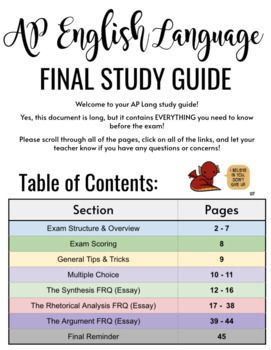AP English Language and Composition Exam Study Guide
Miss Mendez The Queens Teacher
15 Followers
Grade Levels
9th - 12th
Subjects
Standards
CCSSRI.11-12.1
CCSSRI.11-12.2
CCSSRI.11-12.3
CCSSRI.11-12.4
CCSSCCRA.L.3
Formats Included
- Google Drive™ folder
Pages
45 pages
Miss Mendez The Queens Teacher
15 Followers

Made for Google Drive™
This resource can be used by students on Google Drive or Google Classroom. To access this resource, you’ll need to allow TPT to add it to your Google Drive. See our FAQ and Privacy Policy for more information.
Description
This document is 44+ pages of review for the AP English Language and Composition exam. It contains information about:
- Writing with sources
- Annotating prompts
- Rhetorical analysis
- Identifying the rhetorical situation
- Argumentative writing with background knowledge
- Sample top scoring responses
- The structure of the exam & how the exam is scored
- Links to helpful YouTube videos that walk you through concepts you might have missed
- and more!
It goes section by section of the exam and gives you tips and tricks for the Multiple Choice portion, the Synthesis Essay, the Rhetorical Analysis Essay, and the Argument Essay. Sentence starters, thesis frames, descriptions of rhetorical devices, the rhetorical situation, sample essays, sample paragraphs, and more are all included!
Total Pages
45 pages
Answer Key
N/A
Teaching Duration
N/A
Report this resource to TPT
Reported resources will be reviewed by our team. Report this resource to let us know if this resource violates TPT’s content guidelines.
Standards
to see state-specific standards (only available in the US).
CCSSRI.11-12.1
Cite strong and thorough textual evidence to support analysis of what the text says explicitly as well as inferences drawn from the text, including determining where the text leaves matters uncertain.
CCSSRI.11-12.2
Determine two or more central ideas of a text and analyze their development over the course of the text, including how they interact and build on one another to provide a complex analysis; provide an objective summary of the text.
CCSSRI.11-12.3
Analyze a complex set of ideas or sequence of events and explain how specific individuals, ideas, or events interact and develop over the course of the text.
CCSSRI.11-12.4
Determine the meaning of words and phrases as they are used in a text, including figurative, connotative, and technical meanings; analyze how an author uses and refines the meaning of a key term or terms over the course of a text (e.g., how Madison defines faction in Federalist No. 10).
CCSSCCRA.L.3
Apply knowledge of language to understand how language functions in different contexts, to make effective choices for meaning or style, and to comprehend more fully when reading or listening.


